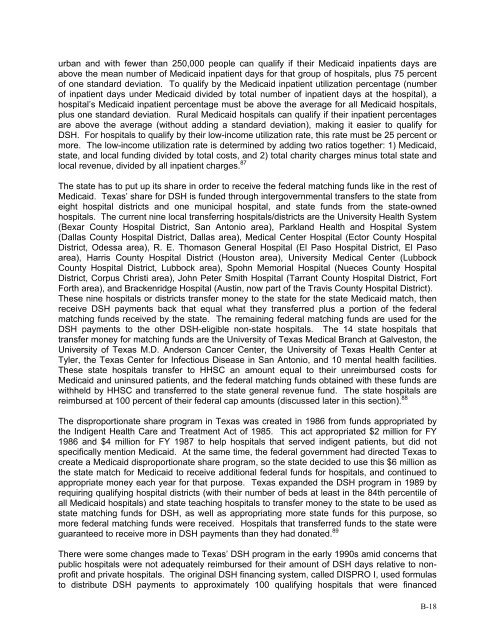COD E R E D
Download - Code Red: The Critical Condition of Health in Texas
Download - Code Red: The Critical Condition of Health in Texas
- No tags were found...
You also want an ePaper? Increase the reach of your titles
YUMPU automatically turns print PDFs into web optimized ePapers that Google loves.
urban and with fewer than 250,000 people can qualify if their Medicaid inpatients days areabove the mean number of Medicaid inpatient days for that group of hospitals, plus 75 percentof one standard deviation. To qualify by the Medicaid inpatient utilization percentage (numberof inpatient days under Medicaid divided by total number of inpatient days at the hospital), ahospital’s Medicaid inpatient percentage must be above the average for all Medicaid hospitals,plus one standard deviation. Rural Medicaid hospitals can qualify if their inpatient percentagesare above the average (without adding a standard deviation), making it easier to qualify forDSH. For hospitals to qualify by their low-income utilization rate, this rate must be 25 percent ormore. The low-income utilization rate is determined by adding two ratios together: 1) Medicaid,state, and local funding divided by total costs, and 2) total charity charges minus total state andlocal revenue, divided by all inpatient charges. 87The state has to put up its share in order to receive the federal matching funds like in the rest ofMedicaid. Texas’ share for DSH is funded through intergovernmental transfers to the state fromeight hospital districts and one municipal hospital, and state funds from the state-ownedhospitals. The current nine local transferring hospitals/districts are the University Health System(Bexar County Hospital District, San Antonio area), Parkland Health and Hospital System(Dallas County Hospital District, Dallas area), Medical Center Hospital (Ector County HospitalDistrict, Odessa area), R. E. Thomason General Hospital (El Paso Hospital District, El Pasoarea), Harris County Hospital District (Houston area), University Medical Center (LubbockCounty Hospital District, Lubbock area), Spohn Memorial Hospital (Nueces County HospitalDistrict, Corpus Christi area), John Peter Smith Hospital (Tarrant County Hospital District, FortForth area), and Brackenridge Hospital (Austin, now part of the Travis County Hospital District).These nine hospitals or districts transfer money to the state for the state Medicaid match, thenreceive DSH payments back that equal what they transferred plus a portion of the federalmatching funds received by the state. The remaining federal matching funds are used for theDSH payments to the other DSH-eligible non-state hospitals. The 14 state hospitals thattransfer money for matching funds are the University of Texas Medical Branch at Galveston, theUniversity of Texas M.D. Anderson Cancer Center, the University of Texas Health Center atTyler, the Texas Center for Infectious Disease in San Antonio, and 10 mental health facilities.These state hospitals transfer to HHSC an amount equal to their unreimbursed costs forMedicaid and uninsured patients, and the federal matching funds obtained with these funds arewithheld by HHSC and transferred to the state general revenue fund. The state hospitals arereimbursed at 100 percent of their federal cap amounts (discussed later in this section). 88The disproportionate share program in Texas was created in 1986 from funds appropriated bythe Indigent Health Care and Treatment Act of 1985. This act appropriated $2 million for FY1986 and $4 million for FY 1987 to help hospitals that served indigent patients, but did notspecifically mention Medicaid. At the same time, the federal government had directed Texas tocreate a Medicaid disproportionate share program, so the state decided to use this $6 million asthe state match for Medicaid to receive additional federal funds for hospitals, and continued toappropriate money each year for that purpose. Texas expanded the DSH program in 1989 byrequiring qualifying hospital districts (with their number of beds at least in the 84th percentile ofall Medicaid hospitals) and state teaching hospitals to transfer money to the state to be used asstate matching funds for DSH, as well as appropriating more state funds for this purpose, somore federal matching funds were received. Hospitals that transferred funds to the state wereguaranteed to receive more in DSH payments than they had donated. 89There were some changes made to Texas’ DSH program in the early 1990s amid concerns thatpublic hospitals were not adequately reimbursed for their amount of DSH days relative to nonprofitand private hospitals. The original DSH financing system, called DISPRO I, used formulasto distribute DSH payments to approximately 100 qualifying hospitals that were financedB-18







